Instant Pot Wine
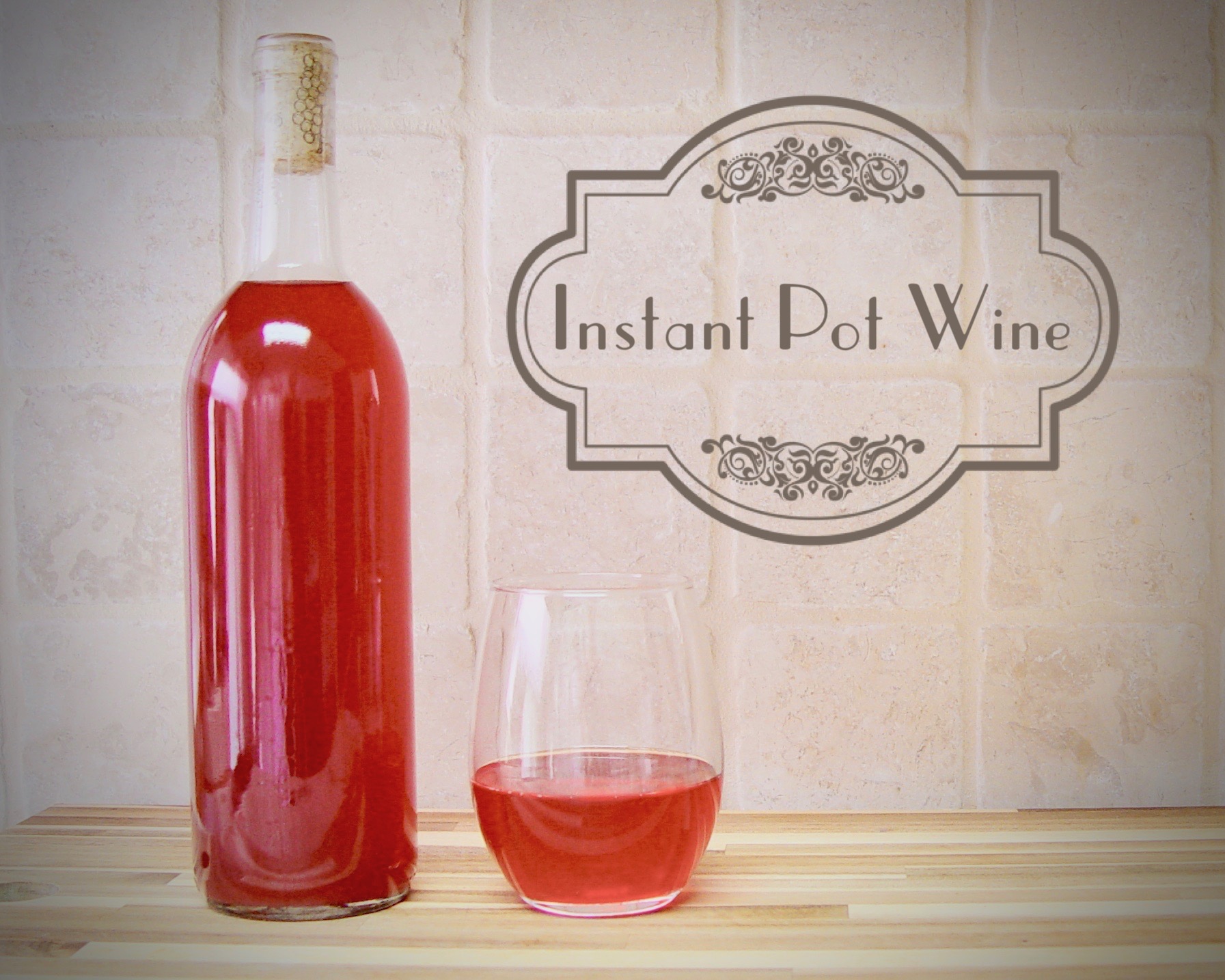
Is this too good to be true? What kind of trickery is this? Can an Instant Pot even make wine? Yes!
You won't be able to just toss some juice, sugar, and yeast into your Instant Pot in the morning and by nighttime have yourself a glass of wine. However, by starting the fermentation off in your Instant Pot - using the yogurt function - you can significantly reduce the amount of time it takes to make wine to less than 2 weeks. As a wine hobbyist, it takes a few months to produce a batch of wine, so 2 weeks is a dream!
After the initial Instant Pot yeast kickstart, I've provided two methods of fermentation: the "hobbyist" way (with wine yeast, an airlock, and a growler) or the "I'll use what I have" way (bread yeast, a plastic jug, and balloon). Read to the end to find out which way we think tastes the best!
Ingredients & Tools
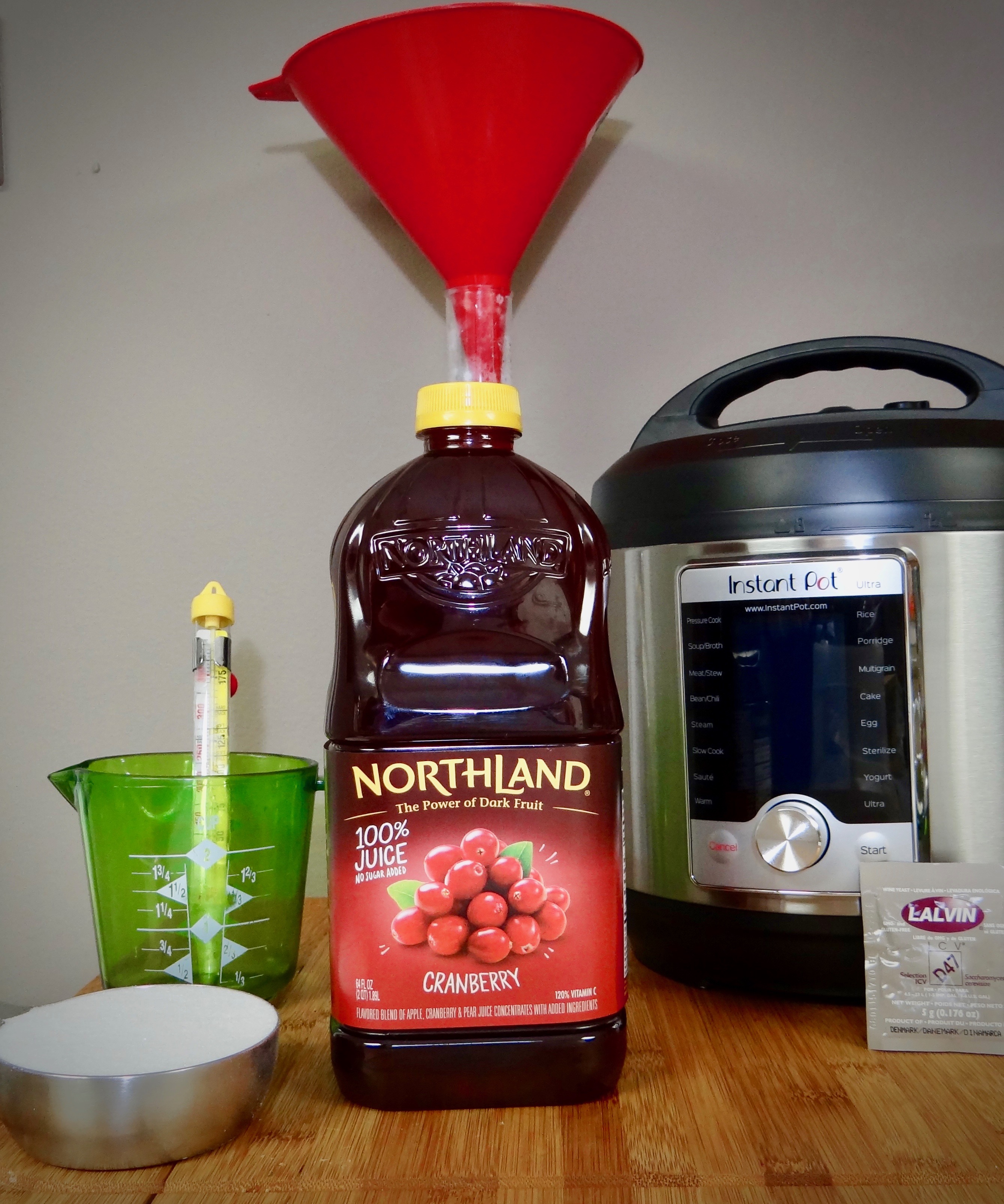
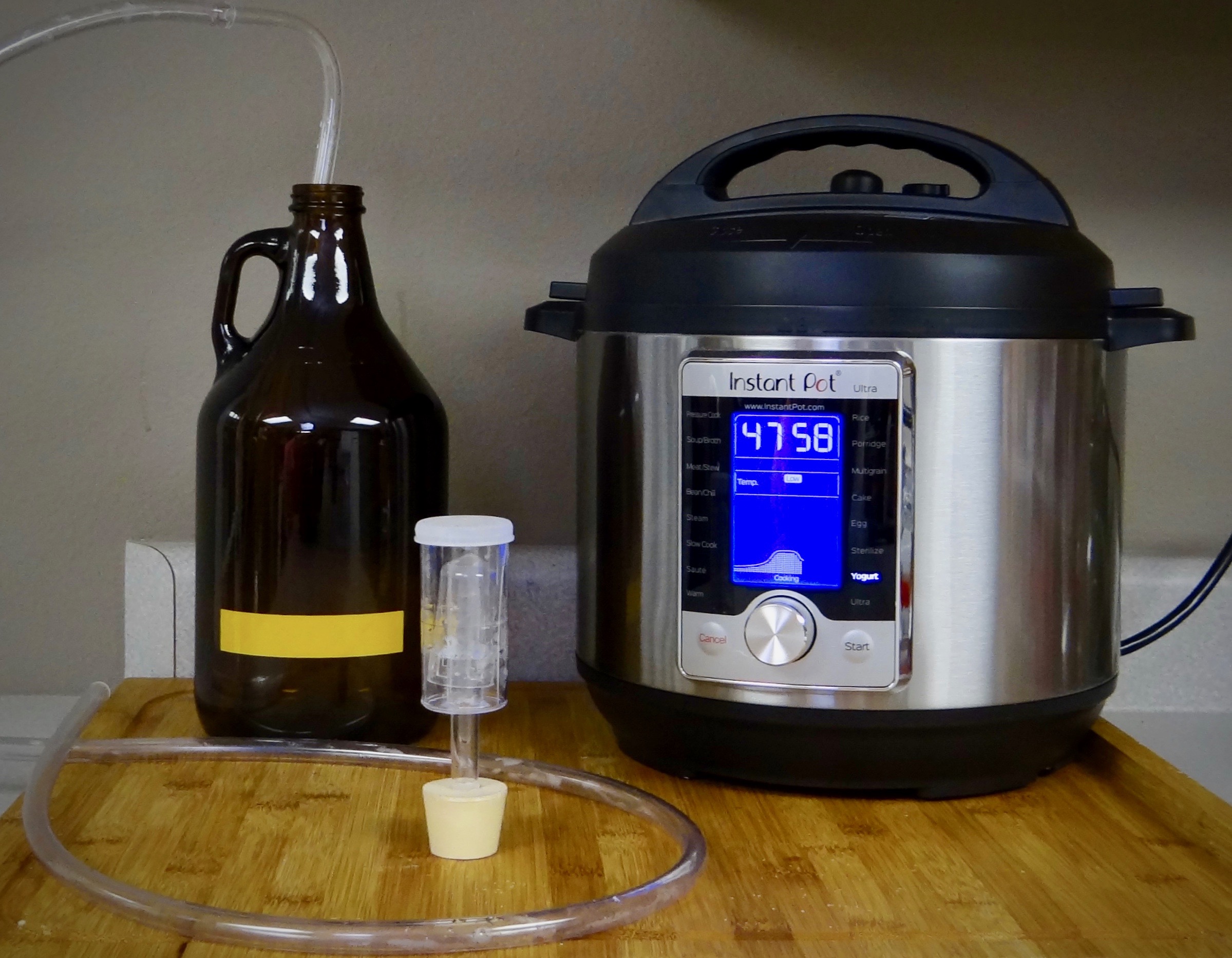
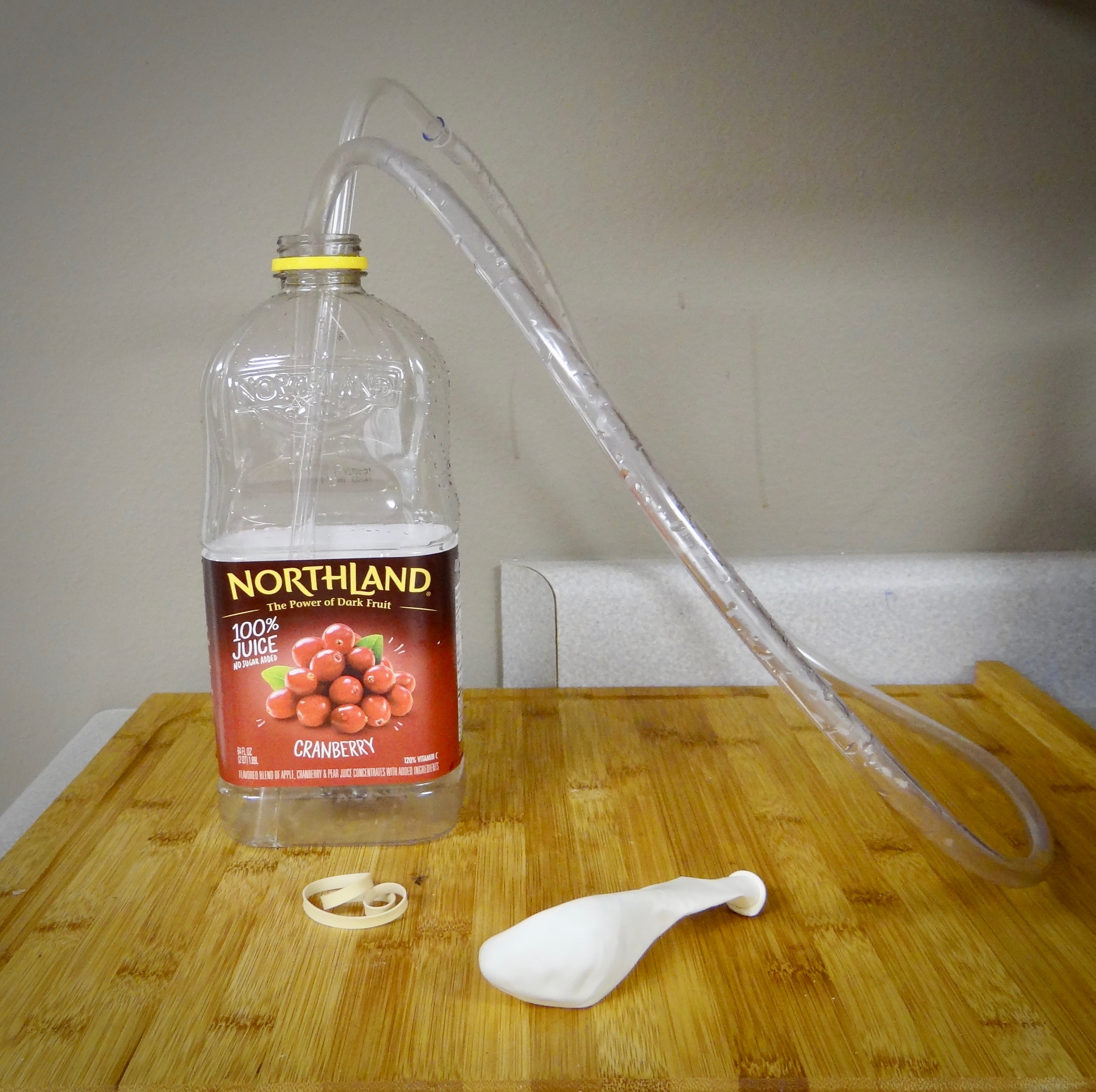
Part I - Must Haves:
- 64 oz 100% juice, not concentrate and doesn't contain preservatives (I used cranberry juice because I love tart wine)
- 1 cup sugar
- 1/2 packet of yeast, either a wine yeast or bread yeast
- Funnel
- Instant Pot with yogurt function
- Thermometer
Part II - "Hobbyist" Method:
- 1/2 gallon growler (the brown glass jug in the picture)
- Airlock
- Rubber stopper
- Fermentation tubing
- Hydrometer (measures alcohol percentage)
- Empty wine bottles to store wine
Part II - "I'll Use What I Have" Method:
- The plastic juice jug it came in
- Balloon
- Needle or safety pin to poke holes
- Rubberband
- Fish tank tubing from Walmart or pet store
- Another empty juice jug or any vessel to store wine
Fermentation Instant Pot Kickstart
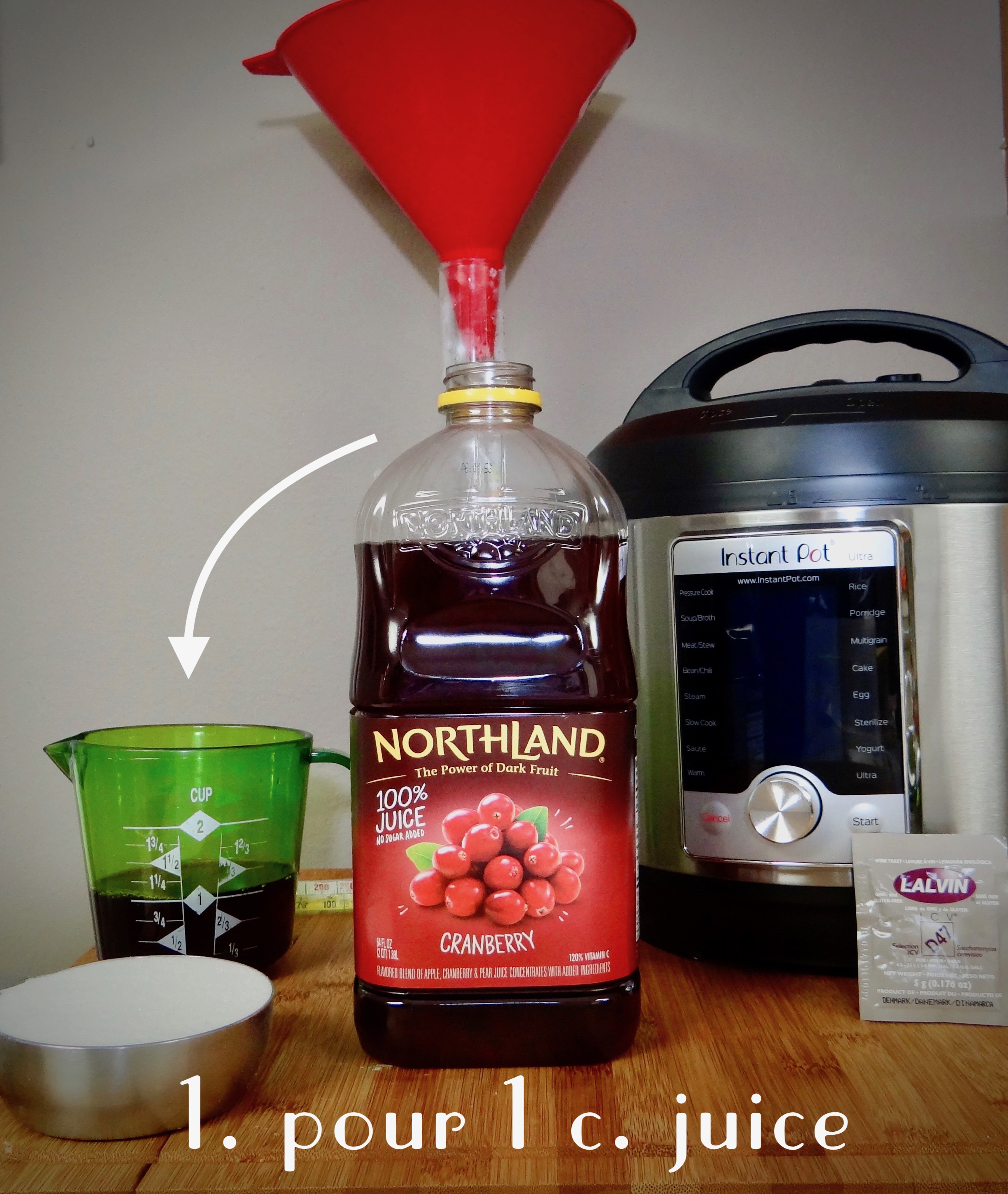
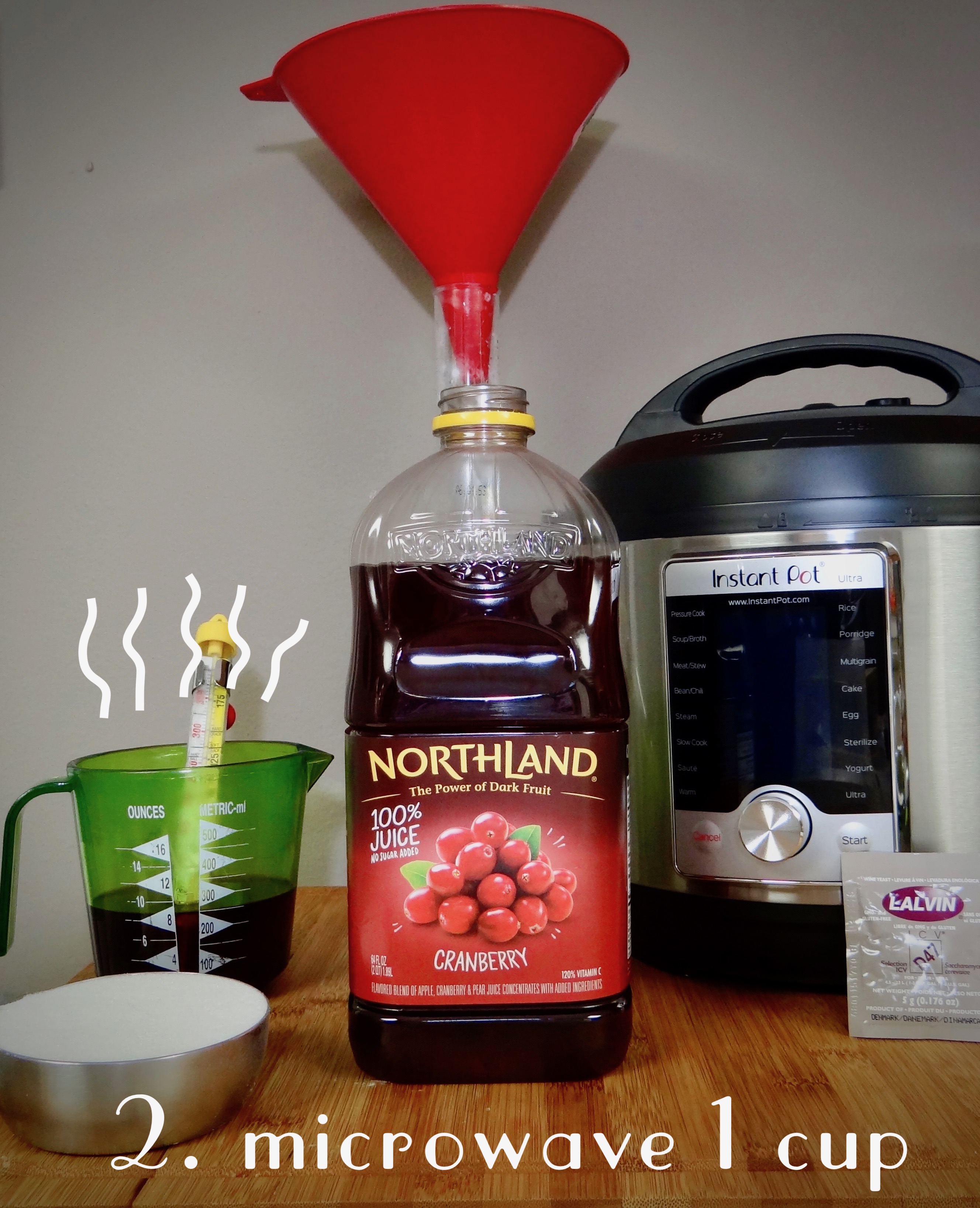
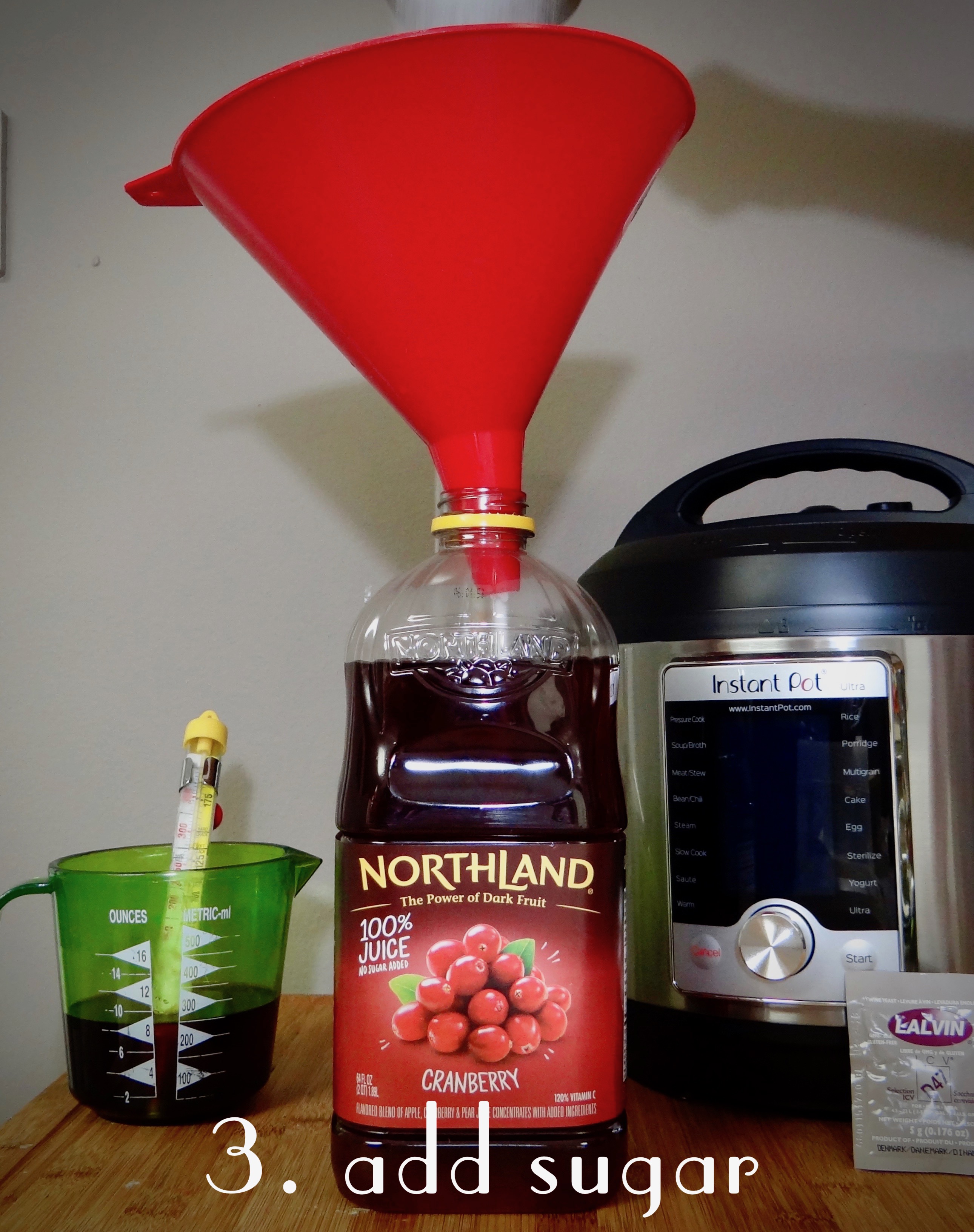
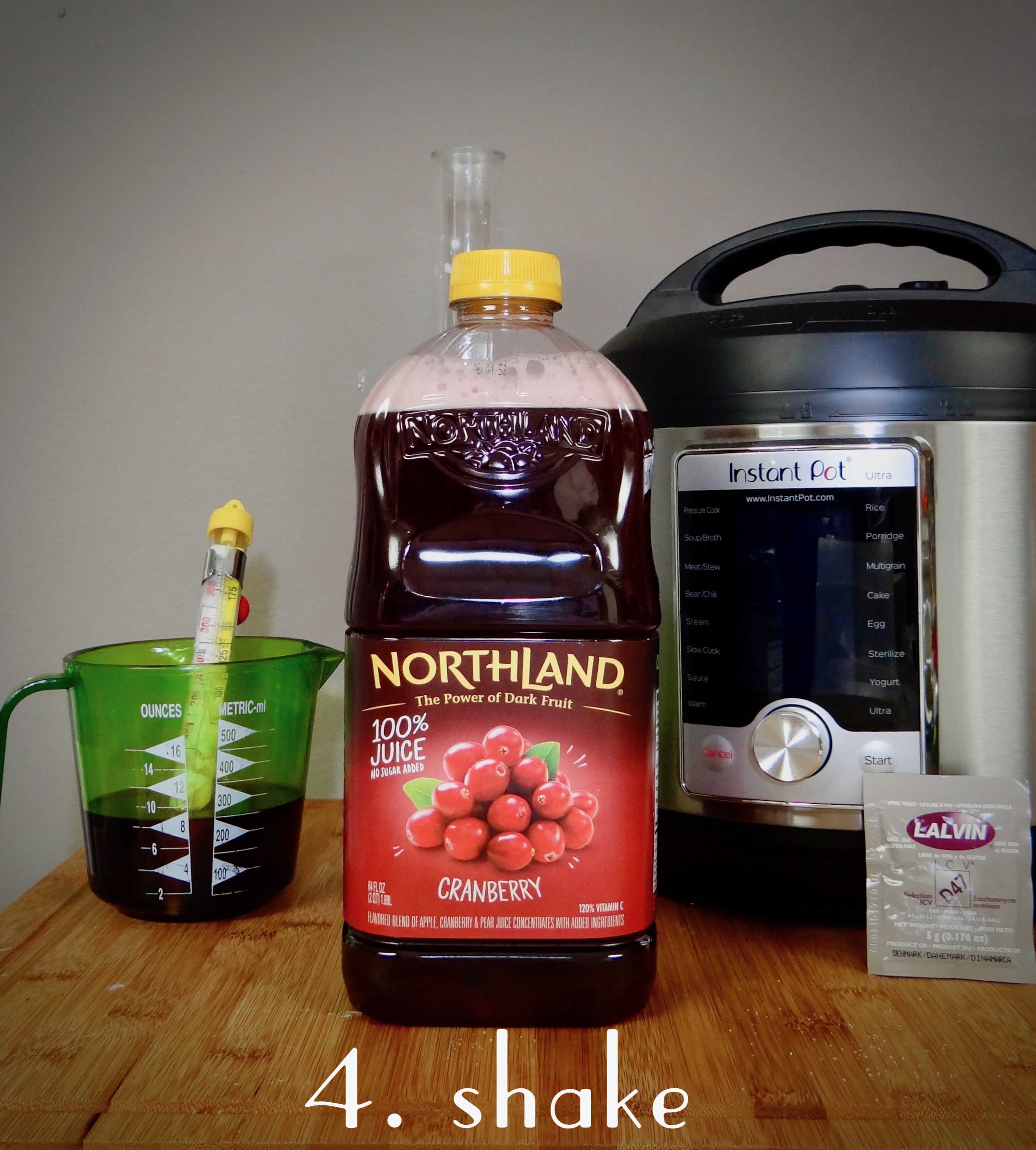
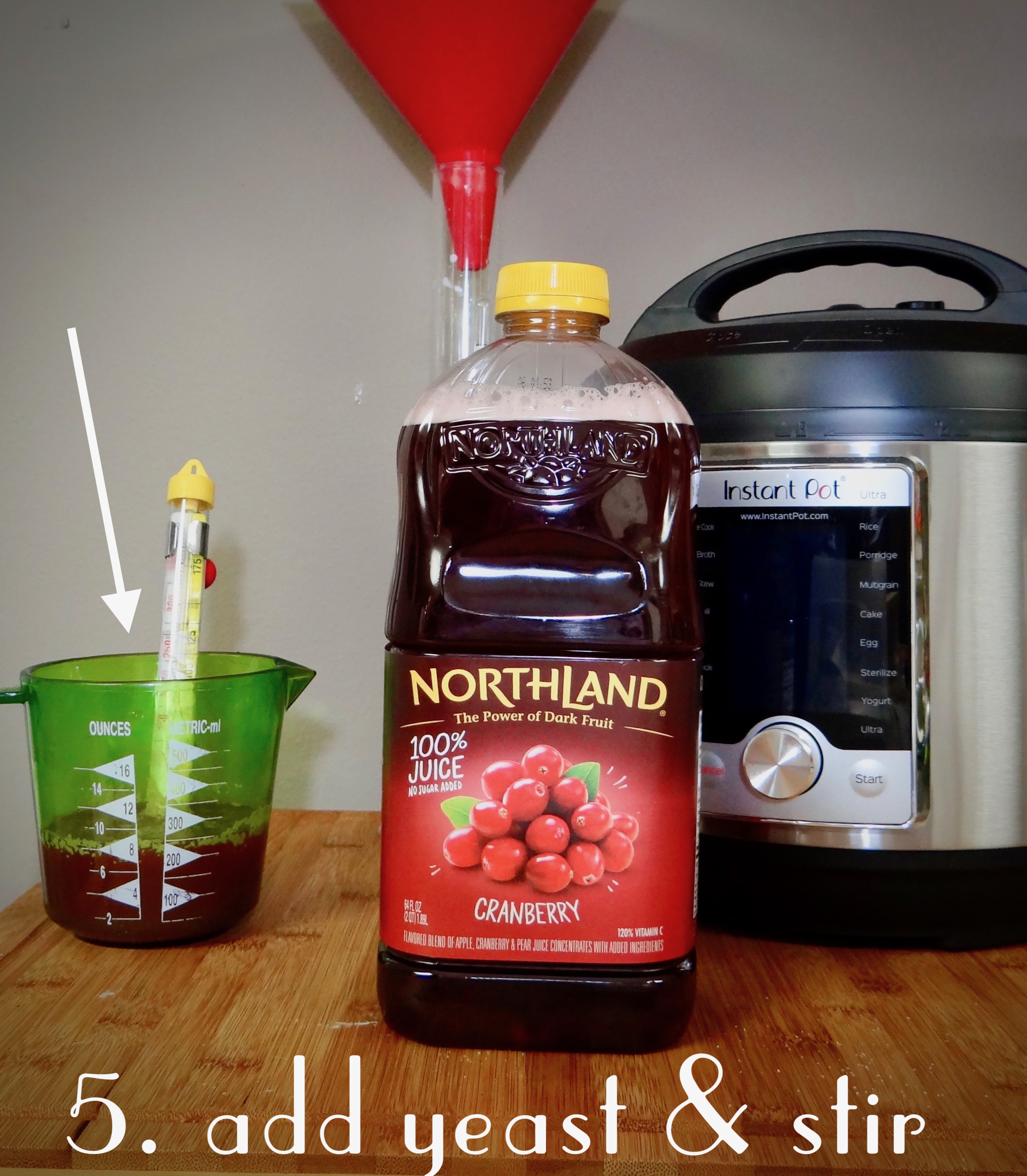
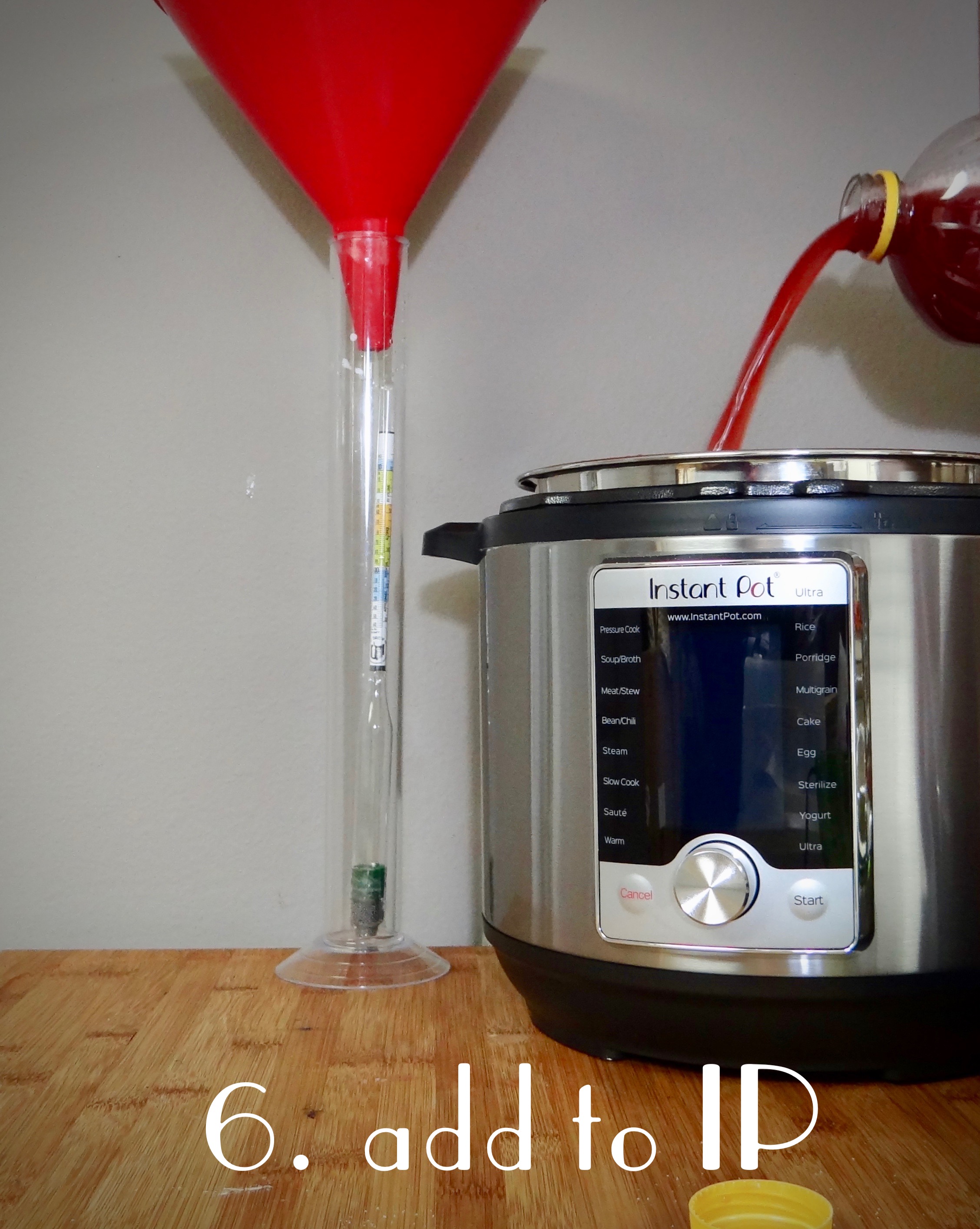
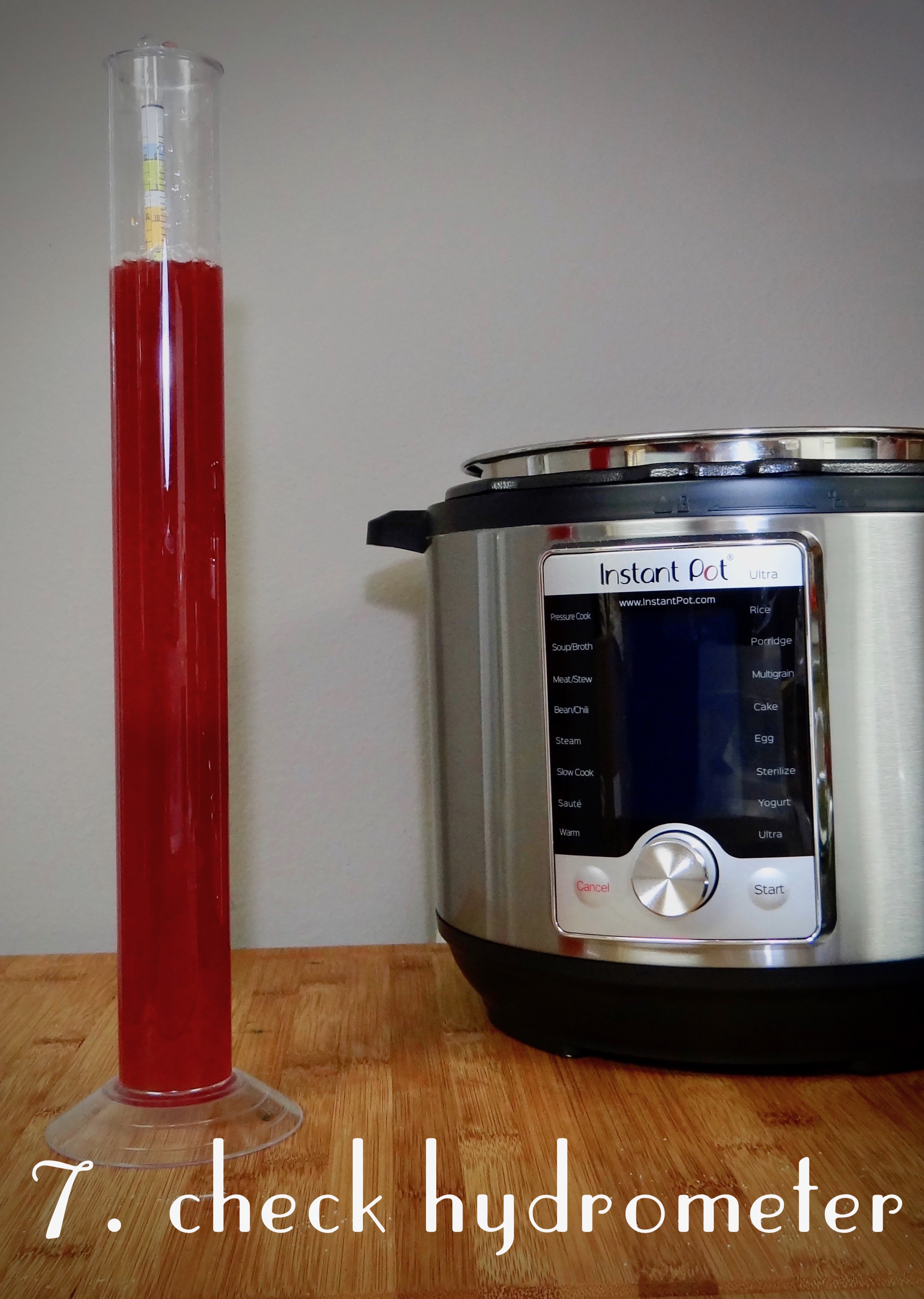
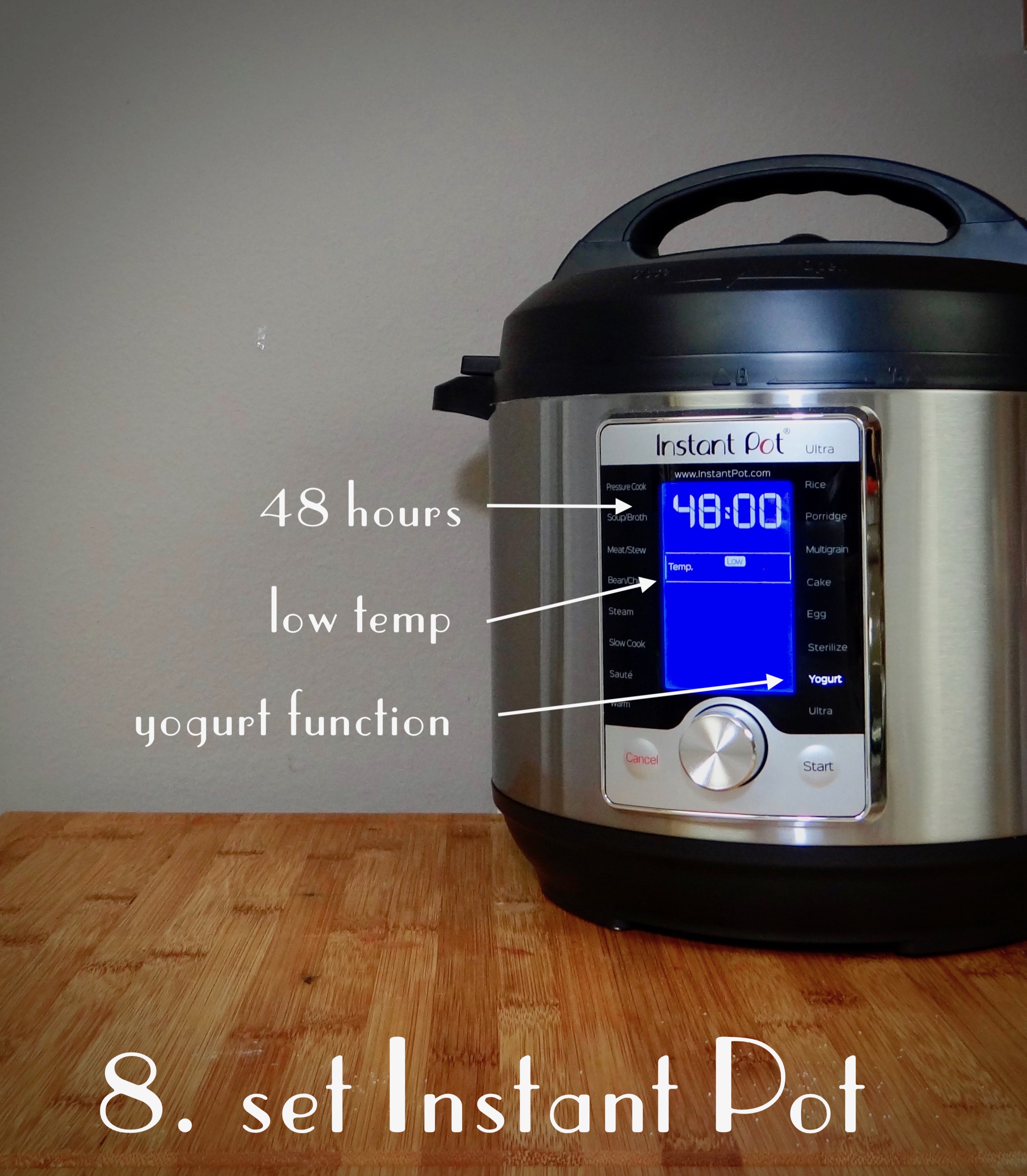
Before you start, sanitize all of the equipment you are using. I use a wine-making cleaner and sanitizer to minimize the potential of a bad yeast or bacteria strain contaminating the wine. However, you can use boiling hot water. Do not use bleach to sanitize your Instant Pot or supplies and don't wash with soap as it can leave behind a film.
- Pour out 1 cup of juice into a measuring cup. Don't throw it away, as you will add it back in later.
- Heat the 1 cup of juice in the microwave up to the temperature stated on the yeast package. You are going to "wake up" the yeast before adding it to the Instant Pot, but different yeasts like to be activated at different temperatures. The wine yeast I used wanted 104-109 degrees but the bread yeast wanted around 120-130 degrees. If your juice gets too warm, cool it down to the desired temp before adding the yeast, or you could damage/kill it.
- Add 1 cup of sugar to the juice bottle by pouring it through the funnel.
- Cap the bottle and shake until the sugar is dissolved, around two minutes.
- When the cup of juice is the right temp, add yeast and stir. This step is a couple steps after you've heated the juice because, naturally, I always overheat the juice and have to wait for it to cool down. Because the yeast has been introduced, from now on it is imperative that everything the soon-to-be-wine touches has been sterilized.
- Pour about 2 cups of juice from the bottle into the Instant Pot liner. Then, add the yeast/juice mixture into the bottle and gently shake. (You are just making room for the yeast/juice mixture in the bottle.) I add this extra mixing step to ensure all the yeast is blended in the pot and doesn't immediately clump to the sides or bottom of the Instant Pot. Add everything to the Instant Pot and stir gently. Save the juice bottle if you are using it for fermentation later.
- Optional: check hydrometer. If you have a hydrometer, now is the time to check the alcohol potential of your wine. It will very likely be around 10% potential alcohol by volume, but could fluctuate dependent on how much sugar is already in the juice you purchased.
- Set your Instant Pot: For the IP Ultra, set the function to Yogurt, 48 hours, and low temp (91 degrees). For other models, you may need to set it at 81 degrees for 24 hours and set it again the next day. Set the release to Open.
- Open/Close Release every 6-8 hours: Starting with the Instant Pot release valve in the open position, alternate between open and closed roughly every 6-8 hours for the whole two days. This allows the pot to release the bad gasses the yeast is emitting and not infuse it back into the wine.
This is where your Instant Pot really preforms the magic of speeding up the wine making process. Warmth and food are two things yeast love. So what you're doing is providing the best home for them while they multiply. Then, when the wine and yeast get transferred to a secondary vessel to start fermenting, you'll have the time-saving advantage of more yeast to convert sugars to alcohol!
Rack Into Fermentation Jug
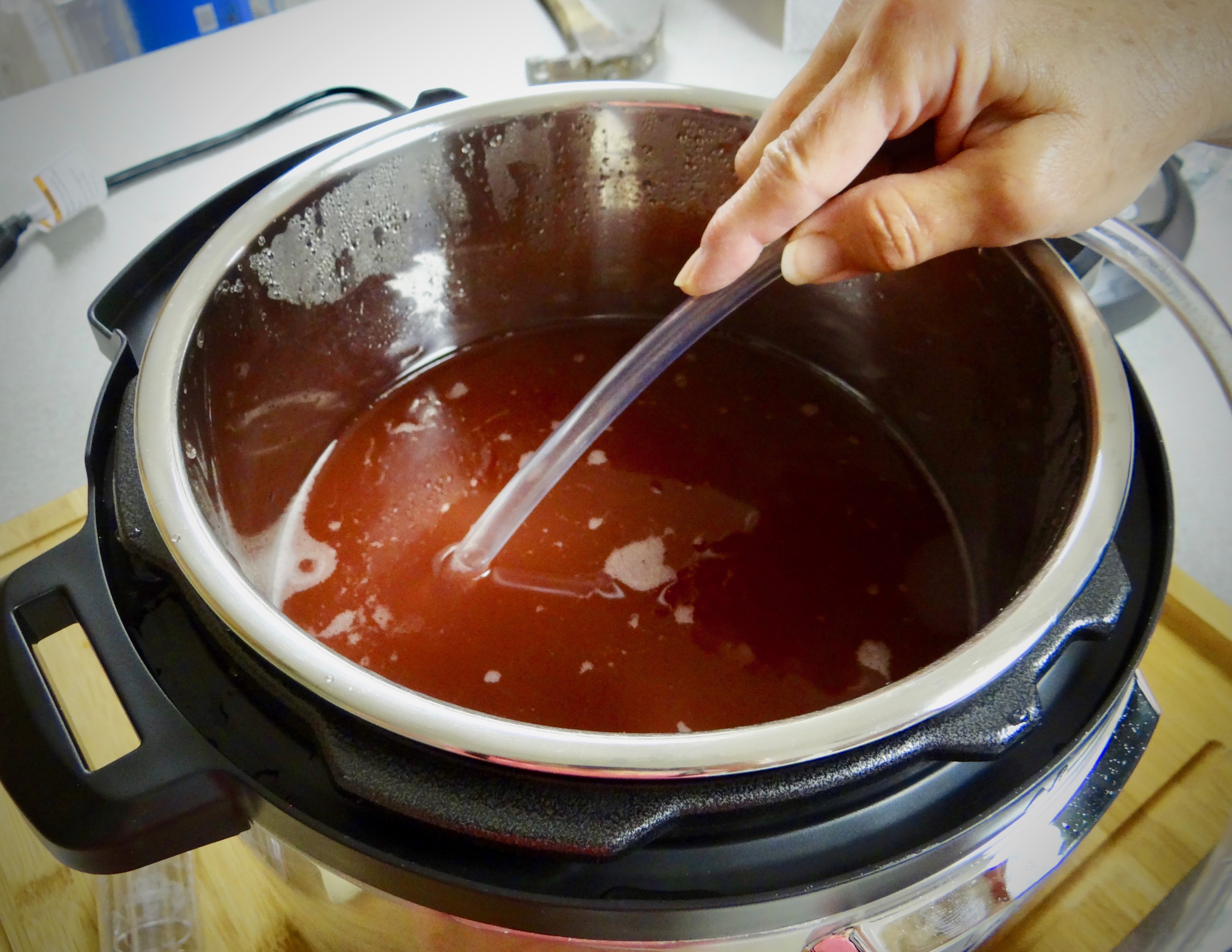
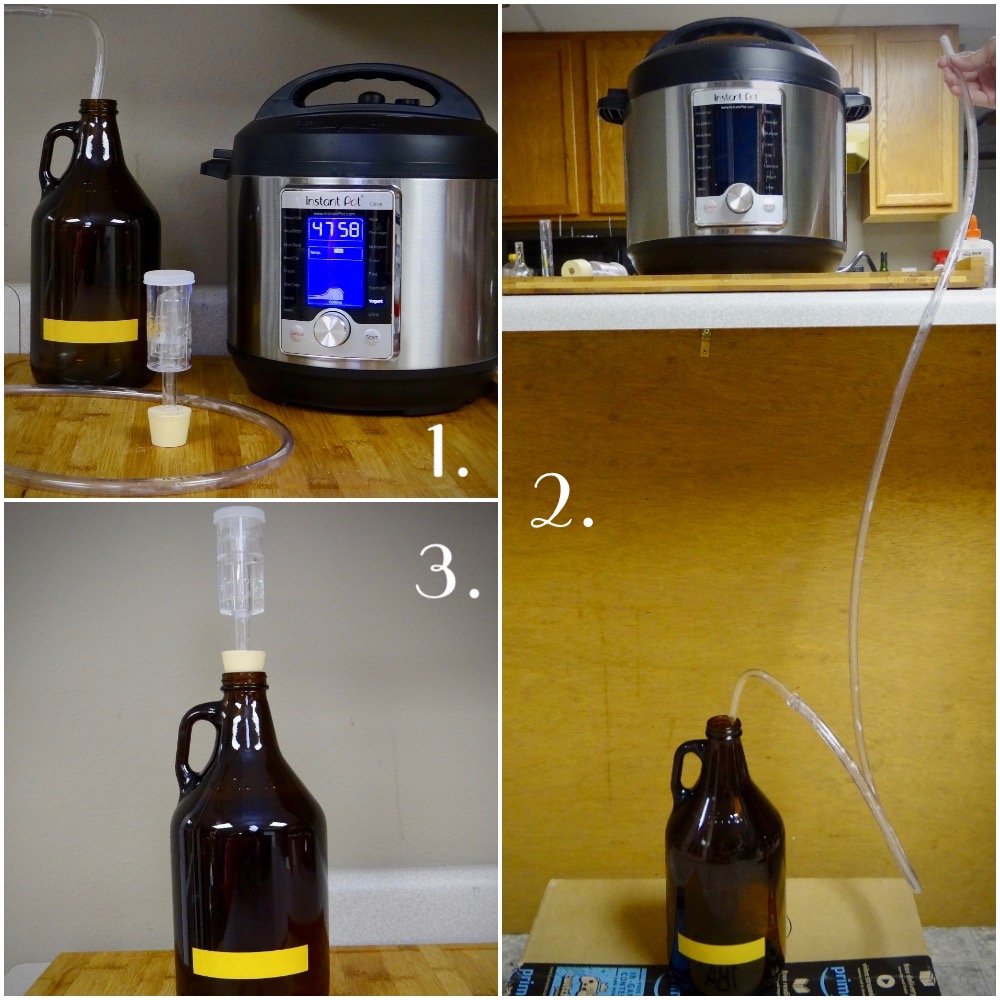

This is the big moment; after 48 hours of patience, you get to check and see if your yeast did it's thang! When you open the Instant Pot lid, you should see bubbles and smell a yeasty alcohol aroma. Now you need to "rack" your wine, which means separating your wine off the old sediment and moving the liquid from one container to another. Afterwards, you will see a sludgy substance on the bottom of the liner; this is dead yeast. We don't want our wine sitting on dead yeast for too long or it will affect the taste. When racking our wine, we want to introduce the least amount of oxygen as possible, which is why we use tubing instead of just pouring the wine into the funnel down into the bottle. This is also why we are using a fermenting container that is almost the same volume as the liquid; you would not want to use a gallon carboy for a half-gallon (64 oz) recipe like this one, as there would be too much space in the container.
"Hobbyist" Racking Method:
- Gather your sanitized materials: tubing, an airlock, and a glass growler.
- Rack liquid from the Instant Pot to the growler: do this by placing the Instant Pot on a tall surface, like a counter, and your growler on the floor. Racking uses gravity to siphon the liquid from one vessel to another. Place one end of the tubing into the Instant Pot and one near the growler. Create a suction with your mouth on the end of the growler side tubing until you see the wine starting to travel down the tubing. Immediately place the end of the tubing into the bottom of the growler, or if your tubing is too short, along the side. Again, we're trying to keep from mixing the wine with air as much as possible. As the pot empties, ensure you are not touching the tubing to the bottom of the Instant Pot; we don't want yeast sludge in the growler! It's completely okay to leave a little liquid in the pot.
- Fill airlock with water, place it in the rubber stopper, and set tightly on growler. An airlock will allow the yeast gasses to escape the bottle, but won't allow oxygen and bacteria into the bottle.
"I'll Use What I Have" Racking Method:
- Gather your sanitized materials: tubing, a balloon, and the saved juice bottle.
- Rack liquid from the Instant Pot to the juice bottle: do this by placing the Instant Pot on a tall surface, like a counter, and your bottle on the floor. This is just like the "Hobbyist" racking method above, so follow those steps and be just as careful about not introducing any air to the wine. If you are using aquarium tubing instead of the 3/8" fermentation tubing, you will find that the amount of suction you need to start the siphon is significantly less. You will also notice the the aquarium tubing will take a bit more time to transfer the wine.
- Poke 2-4 holes into the balloon (while it's not blown up) and blow up the balloon. You want to make sure air can very slowly escape the balloon. Deflate and wash the balloon, then place it around the mouth of the bottle. The balloon will allow the yeast gasses to escape the bottle, but won't allow oxygen back in. Rubber band around the balloon/mouth of the bottle for extra security.
Fermentation Time
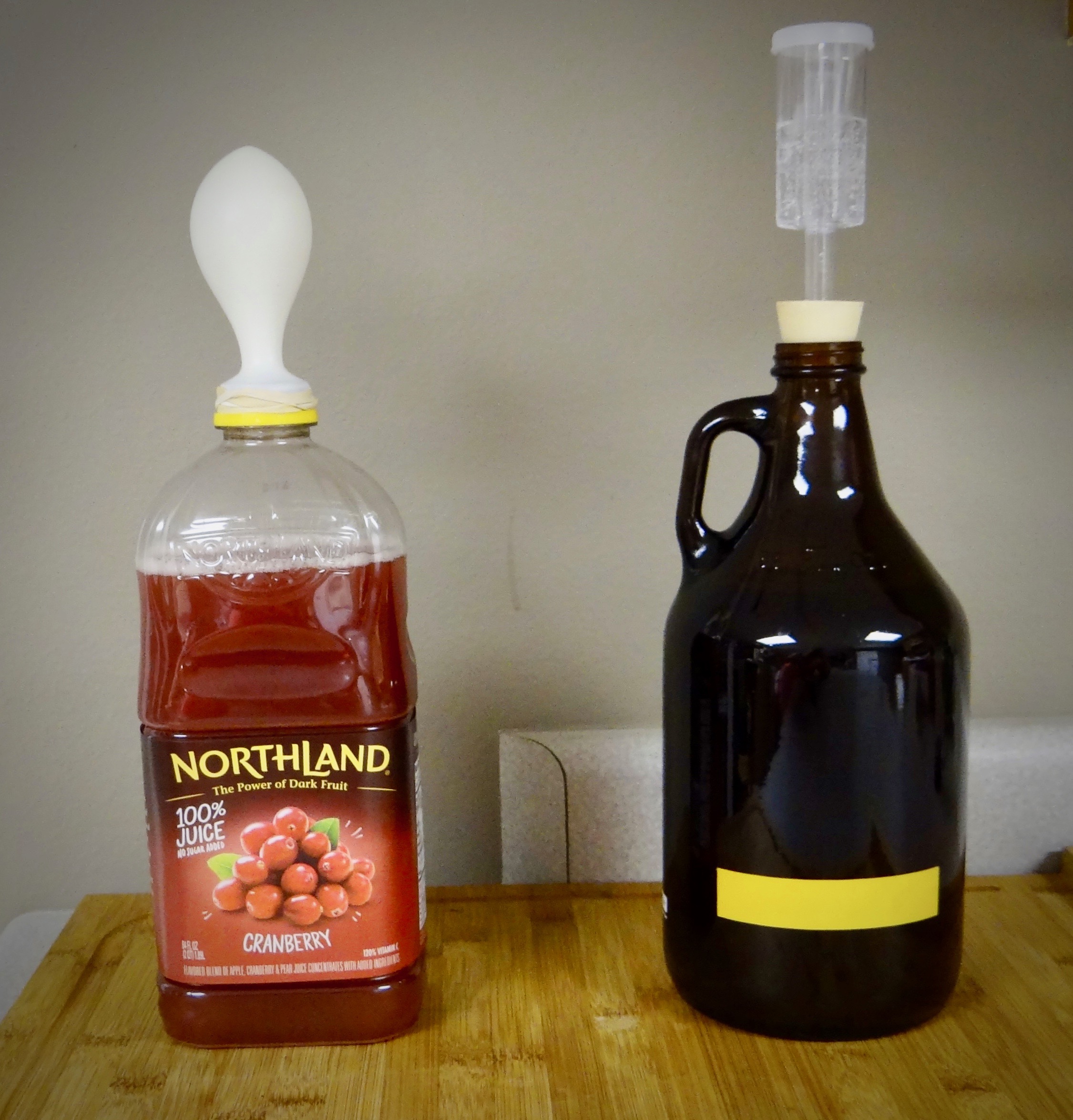
Now we get to wait. How long you wait depends on how dry or sweet you like your wine. I waited 11 days on the wine yeast/airlock method, and got a 9% alcohol wine. This is too dry for my tastes, so I decided to stop the bread yeast/balloon wine at 8 days. I ended up with a 10% alcohol wine (different yeasts will perform differently). Since I started with 10% alcohol potential, this means all of the sugar was eaten by the yeast. Very dry wine!
When the airlock stops bubbling as much, or you've decided on how many days you want to ferment, place the container (airlock/balloon still attached) into the refrigerator. We want to kill off the yeast. (When making large batches of wine, you would want to use Campden tablets or a stabilizer to ensure the yeast was dead. If not, the corks in the bottles could explode! However, since this is such a small amount, I just chill in the fridge for a day or two before the next step.)
Rack Again and (Potentially) Sweeten
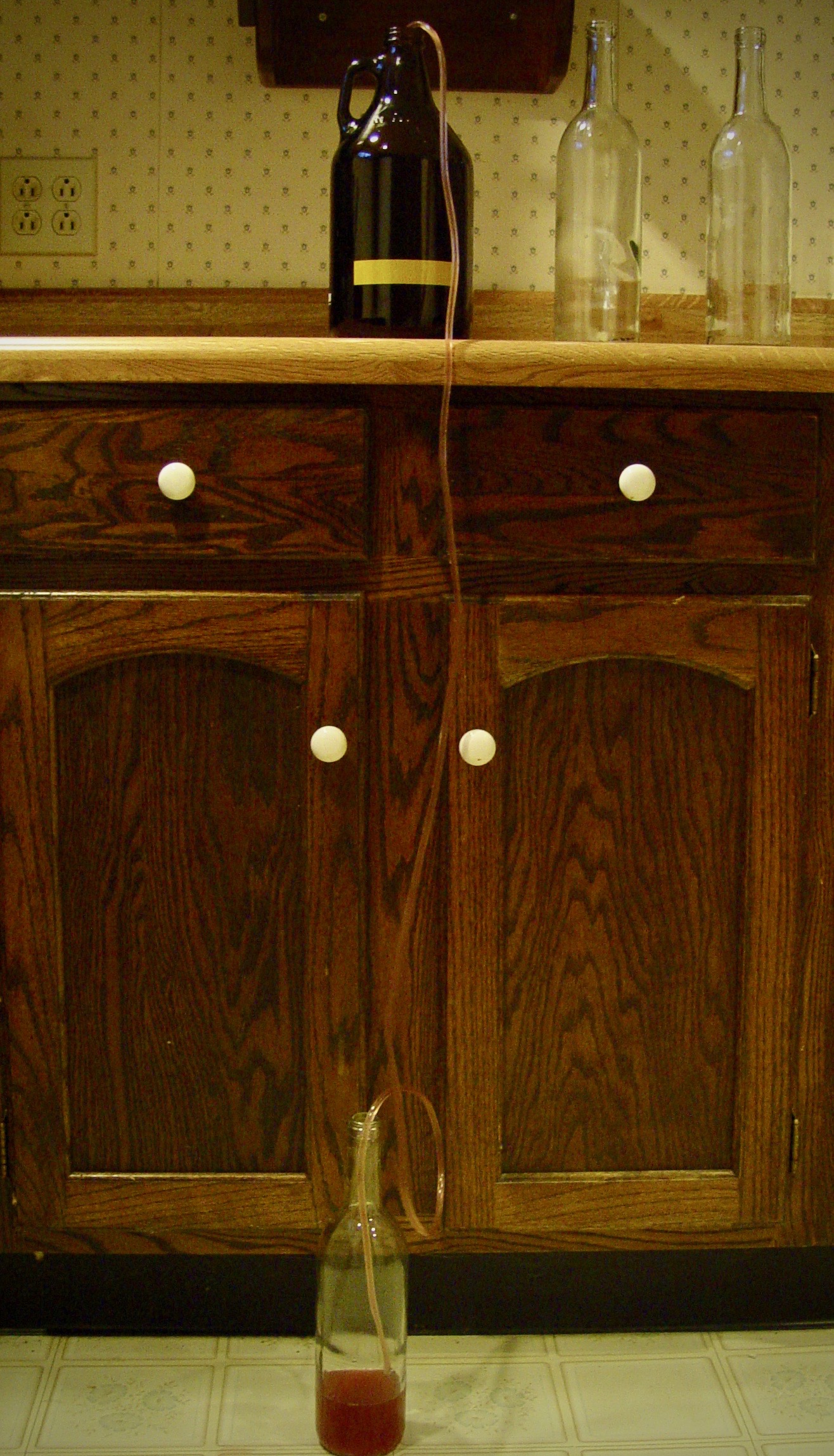
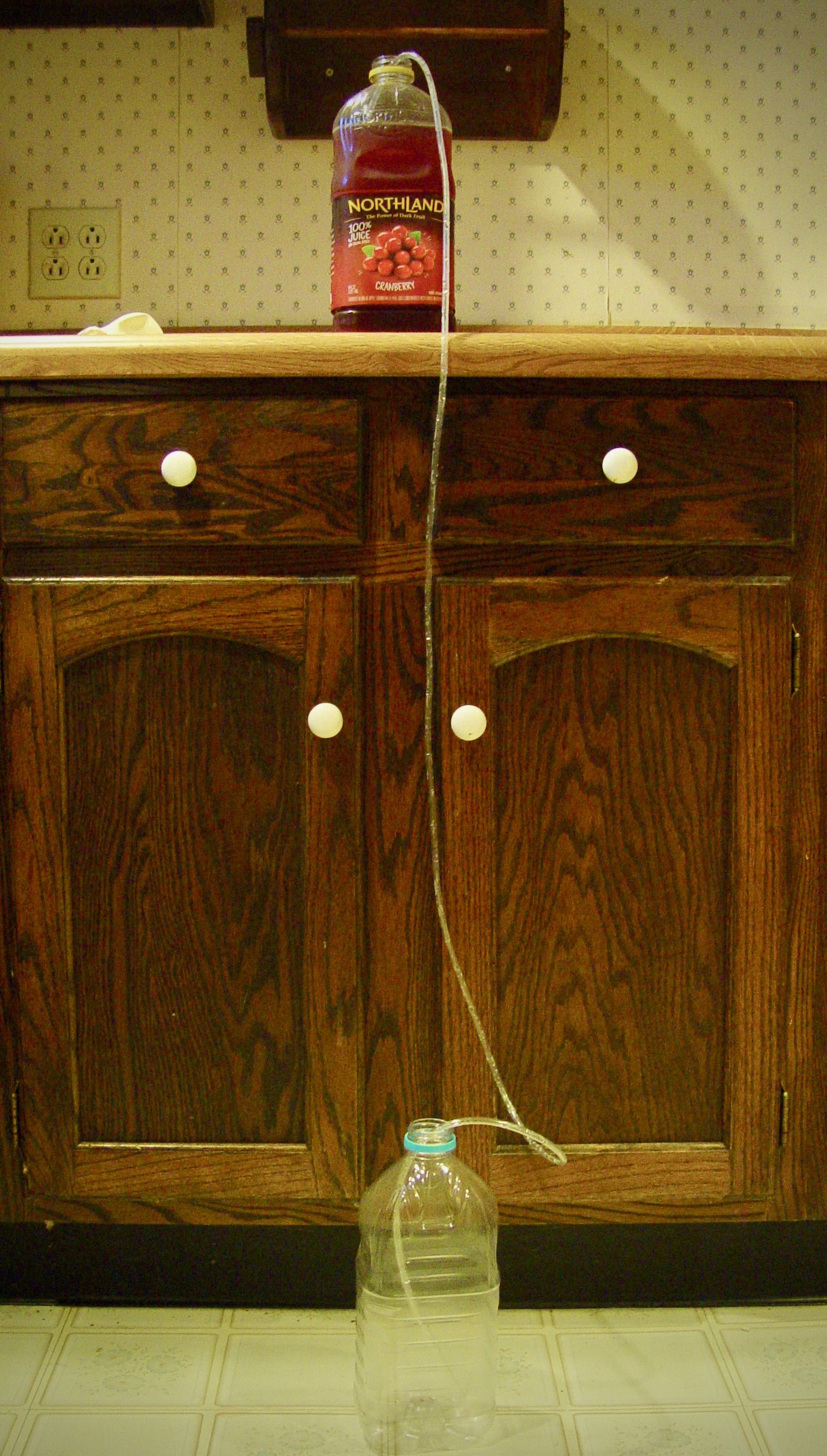

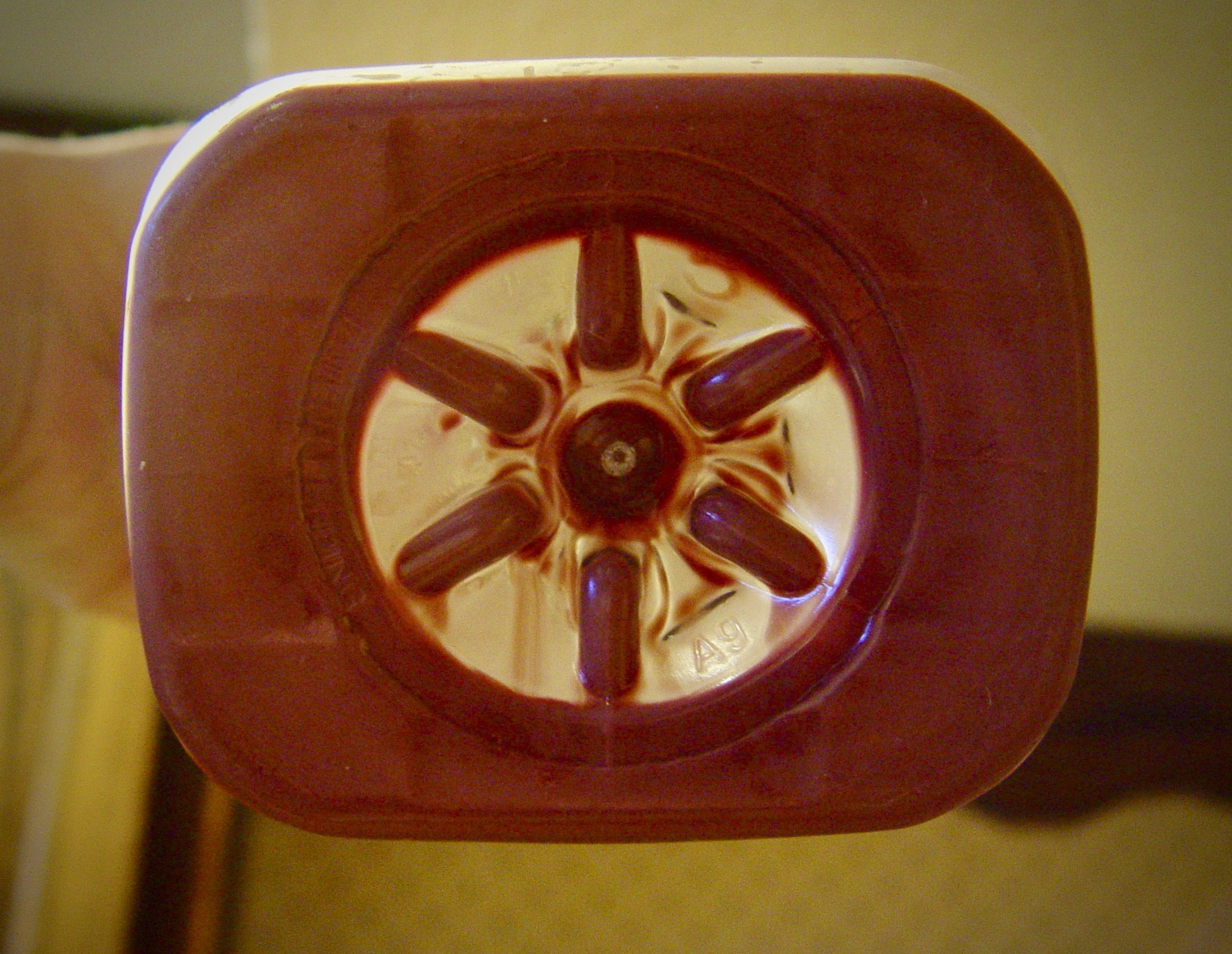
After you've chilled the wine in the fridge for a day or two, most of the yeast should have collected on the bottom of the container. You will want to use the same racking process as before to siphon the wine off the sediment. Once again, keep the tubing off the bottom of the container to make sure you don't suck up any of the dead yeast into your final bottle. You can rack your wine into any container you'd like: wine bottles, another growler, or another juice bottle. I corked my own wine, but that was after testing to make sure the bottles wouldn't continue to fill with gas and explode. To be safe, you might screw your lids on loosely just in case pressure builds up.
We decided not to back sweeten this batch of wine, but it is a very simple process. One way to do it is to measure out 1 cup of your wine and add one tablespoon of sugar at a time until it is as sweet as you desire. Then scale this up to sweeten the rest of your wine. For example, we had about 7-1/2 cups of wine after fermentation and racking our 1/2 gallon of juice. If we wanted to add 4 tablespoons of sugar to one cup of wine, we would then need to add 26 more tablespoons to sweeten the rest of the container.
A simpler way to sweeten your wine is to just keep adding sugar to the whole batch and stopping when its sweet enough. You may run the risk of over-sweetening your wine, however. Also, keep in mind if you sweeten your wine and let it get warm, it may start to ferment again, so keep it chilled and the caps loose. This second round of fermentation is usually prevented by adding Campden tablets and stabilizers in store bought wines. However, just keeping the wine refrigerated will keep it from restarting the fermentation process.
Keep the wine chilled, and I would recommend letting it sit for a few weeks before drinking to let the flavors mellow, but you can drink as soon you'd like! If you time it right you could have three batches going back to back, so one one is ready to drink, another has just finished fermentation, and another is just being started in the Instant Pot! If you keep this up you could have easy, homemade wine for the rest of time! Oh... I'm getting ahead of myself here...
Final Results
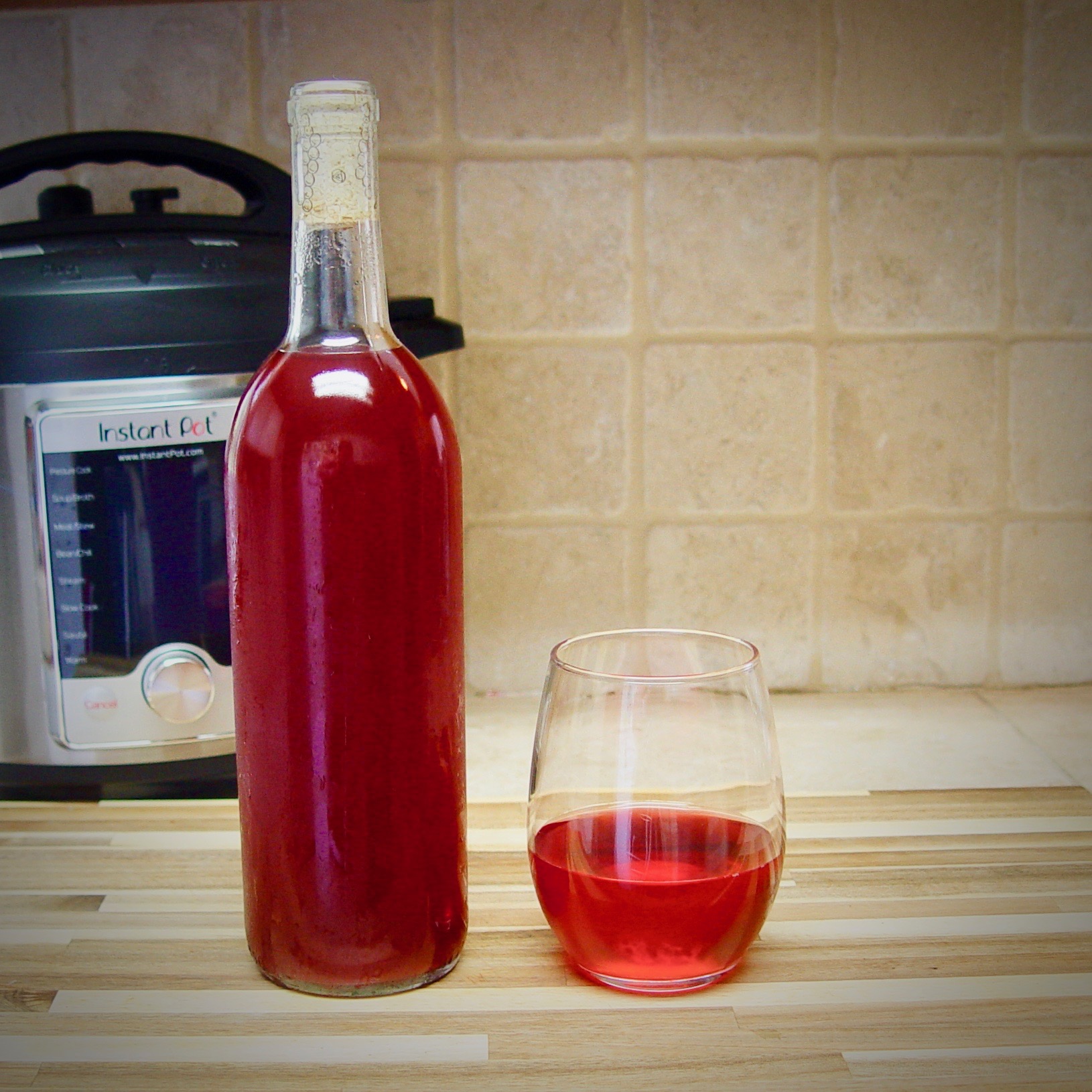
Lucky for us wine lovers - the hobbyists and Instant Pot chefs alike - both methods work. Personally, I think having an airlock and glass bottle is the way to go because we can see the bubbles forming and the gas releasing, rather than a plastic bottle and a latex balloon.
As for yeast type...
This is unfair comparison, as the wine yeast has been resting in the bottle for a few more days than the bread yeast wine... but the winner is the wine yeast! After just a couple of days it tasted a lot smoother. I should add, however, that we usually make our hobby wine with bread yeast and it is absolutely delicious, so I think the bread yeast wine just needs to rest and mellow a little longer.
Have fun with endless wine possibilities!